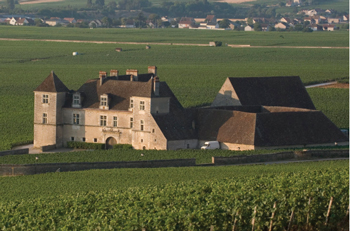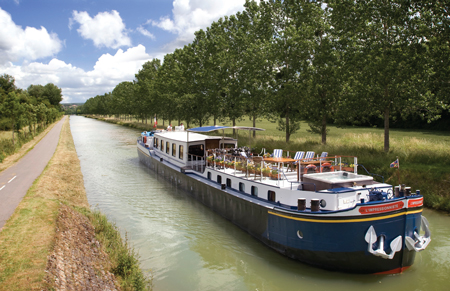I dreamed of floating above a green carpet of vineyards interspersed with trays of fine poultry and meats, with clouds made of Roquefort and Brie. Then I awoke and I was on a barge on the Canal du Bourgogne in France.
My dream and my waking reality were not that much at odds. I was spending a week on L’ Impressionniste, a 126-foot-long hotel barge cruising the Burgundy region. It was late summer, and the vines were full of their famous fruit. All they needed were a few days of rain and a week or so of warm weather, and the harvest could begin.
I had been to France many times and even skippered my own small self-drive barge on several of the picturesque canals. I knew about the slow pace of canal life — cruising at under five miles an hour, the mirror-like reflections on the still water, the photogenic flower-laden locks and their lockkeepers right out of central casting. I did not know that this time I’d be treated to all that plus a movable feast.
I had heard guests were wined and dined aboard L’ Impressionniste. I had read the brochure and the website of GoBarging/European Waterways, owners and operators of the barge. But even being from Northern California and well-acquainted with the bounty of the Napa Valley, I was not prepared for such a gourmet experience.
Dinners for Eight
Unlike sea cruises or even river cruises, the hotel barge trip is an intimate experience. We were four couples—all Americans this week—with a crew of five (L’ Impressionniste can accommodate up to 13). Our captain, James, was an expert navigator and tour guide; all needs were attentively met. Someone happened to notice we all preferred our white wine a bit more chilled than “suggested” temperature, and from that first meal on, the white wine was served to our taste.
With each meal we were offered both white wine and red. Lunches were often served buffet style with fashionable salads, pâtés and cold meats. The potato salad had homemade mayonnaise. Everything was farmers’ market fresh—our chef, Marie, was off to the local towns almost daily to gather the region’s best produce. A few afternoons we had a luscious soup or a warm dish like saffron vegetable risotto with prawns cooked in a persillade.
Dinners were the anticipated event of the day. Marie would come out of the kitchen as soon as we were seated and, with understated flair, present the meal. To say the meals were fine Parisian restaurant quality would not be doing them justice. The thought and creativity going into each dish were evident from the first night’s chilled tomato soup with goat cheese toast followed by succulent confit of duck. Sauces were light and healthy, showcasing the integrity of each ingredient. Presentations begged to be photographed. Menus often stressed the cuisine of the region with Marie’s particular twist—from fillet of lamb with red wine and rosemary reduction to supreme of guinea fowl with a tarragon and raisin sauce.
Each main course was followed by a cheese course, making the on-board bicycles a necessity. (To delight in the cheeses of France, one has to put aside any guilt. For me, promising myself I’d spend at least an hour each day bicycling or walking the canal’s towpaths did the trick.) My favorite was a goat cheese covered in liquor-soaked raisins, aptly named Regal de Bourgogne aux Raisins. Combined with a walnut and caraway seed bread, it was a treat to remember. Desserts were equally unforgettable —strawberry tiramisu, vanilla crème brûlée, crêpes Suzette, chocolate fondant with vanilla custard—served at just the right temperature. The on-board “wine cellar” included some of Burgundy’s finest pinot noir and chardonnay. A Chambolle-Musigny premier cru, a Chassagne-Montrachet premier cru and a Corton-Rognet Grand Cru 1992 were highlights; the captain’s farewell dinner featured a standout Michel Lenique champagne.
Daily activities were often food related as well. After our first day of cruising from the Port of Dijon and traveling past grazing white Charolais cattle, we returned by van to old-town Dijon for the Tuesday flower and produce market. Besides edibles, this sprawling extravaganza in the city’s historical center yielded great bargains in antiques, jewelry and clothing, including a wonderful straw sun hat from Madagascar.
Historic Visits
 Land excursions also included visits to several time-honored châteaux, notably the moat-encircled 13th-century Château de Commarin and the castle of Châteauneuf-en-Auxois. In most cases it had been arranged for us to have the place to ourselves. Without the distraction of other tourists and guides, the sense of history and grandeur of these places vividly came through. At the Château de Commarin we met a current member of the de Vogue family, whose ownership of Commarin went back 26 generations. She rode over the moat by bicycle, a far cry from the bejeweled horse-drawn carriages of yore, but a majestic entrance nonetheless.
Land excursions also included visits to several time-honored châteaux, notably the moat-encircled 13th-century Château de Commarin and the castle of Châteauneuf-en-Auxois. In most cases it had been arranged for us to have the place to ourselves. Without the distraction of other tourists and guides, the sense of history and grandeur of these places vividly came through. At the Château de Commarin we met a current member of the de Vogue family, whose ownership of Commarin went back 26 generations. She rode over the moat by bicycle, a far cry from the bejeweled horse-drawn carriages of yore, but a majestic entrance nonetheless.
A visit to Burgundy is not complete without an afternoon in its capital, Beaune. Dating back nearly two millennia, it served as a focal point for the Gauls and later the Romans, and was the seat for the dukes of Burgundy during the medieval years. Its most famous structure, the 15th-century Hôtel-Dieu (aka Hospices de Beaune), is resplendent with an ornate multicolored tile roof. I saw similar roofs throughout the region on a smaller scale, but this one is truly a work of art.
In Beaune we had a private wine tasting at the city’s oldest winery, Maison Champy. Founded in 1720, it’s set amid the kilometers of caves cut into the limestone beneath the city. Strolling through the subterranean aisles stacked high with famous vintages was like passing through a fine art treasury with a bit of a Halloween feel. Aboveground we were treated to a 2006 Clos-Vougeot Grand Cru and “Old Vintage” 1994 Puligny-Montrachet Premier Cru in an elegant dining room among oak barrels and antique maps. The charming wine hostess discussed the subtleties of each wine, suggesting food pairings for each.
Our floating feast, sadly, had to end. On a Friday evening we reached the canal’s summit, 1,250 feet above sea level at the town of Escomme. Not quite ready to abandon ship, we fantasized about what it would be like to proceed through the Pouilly tunnel and descend to the Loire Valley—a treat not available to hotel barges as of yet. Alas!!
After a week of gourmet greatness, it took a while to come back down to earth. But we each took away fond memories imprinted on our taste buds, along with new friendships and broadened sensory horizons.
If You Go…
• The weather in southern Burgundy is generally warm. June, July and August are usually the warmest months, with little rain.
• Bring comfortable shoes for biking and for walking on the towpaths.
• Unlike on cruise ships, dress on the hotel barge is casual. For the captain’s farewell dinner, casual elegance works best.
• A smattering of French goes a long way when you’re chatting with the lockkeepers and the locals you meet along the towpaths and in the small towns on the canal.
For more information on L’Impressionniste and hotel bargingon the canals of France as well as England, contact European Waterways: 800.394.8630 or 011.44.1784.482439; fax 011.44.178.483072; GoBarging.com


